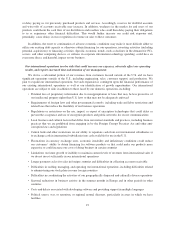Symantec 2012 Annual Report Download - page 103
Download and view the complete annual report
Please find page 103 of the 2012 Symantec annual report below. You can navigate through the pages in the report by either clicking on the pages listed below, or by using the keyword search tool below to find specific information within the annual report.For example, during fiscal 2009, we recorded a non-cash goodwill impairment charge of $7.4 billion,
resulting in a significant net loss for the year. Goodwill is evaluated annually for impairment in the fourth quarter
of each fiscal year or more frequently if events and circumstances warrant as we determined they did in the third
quarter of fiscal 2009, and our evaluation depends to a large degree on estimates and assumptions made by our
management. Our assessment of any impairment of goodwill is based on a comparison of the fair value of each
of our reporting units to the carrying value of that reporting unit. Our determination of fair value relies on
management’s assumptions of our future revenues, operating costs, and other relevant factors. If management’s
estimates of future operating results change, or if there are changes to other key assumptions such as the discount
rate applied to future operating results, the estimate of the fair value of our reporting units could change
significantly, which could result in a goodwill impairment charge. In addition, we evaluate our other long-lived
assets, including intangible assets whenever events or circumstances occur which indicate that the value of these
assets might be impaired. If we determine that impairment has occurred, we could incur an impairment charge
against the value of these assets.
The foregoing types of accounting charges may also be incurred in connection with or as a result of other
business acquisitions. The price of our common stock could decline to the extent that our financial results are
materially affected by the foregoing accounting charges.
If we are unable to attract and retain qualified employees, lose key personnel, fail to integrate replacement
personnel successfully, or fail to manage our employee base effectively, we may be unable to develop new
and enhanced products and services, effectively manage or expand our business, or increase our revenues.
Our future success depends upon our ability to recruit and retain key management, technical, sales,
marketing, finance, and other personnel. Our officers and other key personnel are employees-at-will, and we
cannot assure you that we will be able to retain them. Competition for people with the specific skills that we
require is significant. In order to attract and retain personnel in a competitive marketplace, we believe that we
must provide a competitive compensation package, including cash and equity-based compensation. The volatility
in our stock price may from time to time adversely affect our ability to recruit or retain employees. In addition,
we may be unable to obtain required stockholder approvals of future increases in the number of shares available
for issuance under our equity compensation plans, and accounting rules require us to treat the issuance of equity-
based compensation as compensation expense. As a result, we may decide to issue fewer equity-based incentives
and may be impaired in our efforts to attract and retain necessary personnel. If we are unable to hire and retain
qualified employees, or conversely, if we fail to manage employee performance or reduce staffing levels when
required by market conditions, our business and operating results could be adversely affected.
From time to time, key personnel leave our company. While we strive to reduce the negative impact of such
changes, the loss of any key employee could result in significant disruptions to our operations, including
adversely affecting the timeliness of product releases, the successful implementation and completion of company
initiatives, the effectiveness of our disclosure controls and procedures and our internal control over financial
reporting, and the results of our operations. In addition, hiring, training, and successfully integrating replacement
sales and other personnel could be time consuming, may cause additional disruptions to our operations, and may
be unsuccessful, which could negatively impact future revenues.
Our effective tax rate may increase, which could increase our income tax expense and reduce (increase) our
net income (loss).
Our effective tax rate could be adversely affected by several factors, many of which are outside of our
control, including:
• Changes in the relative proportions of revenues and income before taxes in the various jurisdictions in
which we operate that have differing statutory tax rates
• Changing tax laws, regulations, and interpretations in multiple jurisdictions in which we operate as well
as the requirements of certain tax rulings
24
























